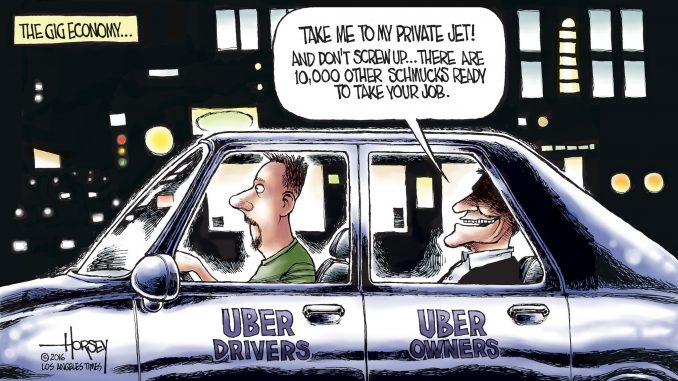
Six New York taxi drivers have committed suicide in the last year. Taxi drivers are now having to work ridiculously long 12-14 hour shifts just to survive. One driver, Doug Shifter, blamed his suicide on having to drive 100-120 hours almost every week. Before shooting himself outside City Hall, he wrote a Facebook post blaming politicians for allowing rideshare companies such as Uber and Lyft to enter the city. The influx of cars from these companies effectively “squeeze[d] rates to below operating costs,” forcing drivers out of the industry and out of a means to support themselves. Another taxi driver in this string of suicides, Yu Mein Chow, had been in extreme debt from a $700,000 loan he had taken out seven years ago to buy his taxi medallion (a license that allows you to operate as a taxi driver). Due to the rapidly increasing size of rideshare companies, he just could not compete with the flood of unlicensed and low-paid drivers entering and taking over the market for cabs.
However, it’s not great for the drivers of these new taxi companies either. In fact, last month New York saw its first Uber driver suicide. Other drivers, like the Chicago Rideshare Advocates, have become so fed up that they’ve begun organizing and protesting for increased wages and safety protections. Since these rideshare drivers are usually considered “independent contractors,” rather than employees, they have no legal protections, nor a minimum wage, health insurance, workers’ compensation, sick pay, overtime, or unemployment benefits. Drivers have to pay their own taxes, maintain their own cars, cover their own insurance, and are responsible for their own gas. They are completely on their own. And since Uber and Lyft compete to dominate the taxi and rideshare market, they have also been increasingly cutting driver pay to lower their prices.
For example, the average Uber driver makes only about ten dollars an hour. Working a 40-hour week at this rate puts them around the federal poverty line for a family of two. Drivers also have no way of knowing how much time they’ll spend or how much money they’ll make each time they work. They can’t see what the destination is until the passenger is picked up. Because of this, there’s no way to tell whether accepting a ride will be a waste of time or not. These companies also collect hidden fees and take high commissions, leaving drivers in the dark about what their full earnings should be. One driver compared working for Uber to gambling, since it’s impossible to predict income or how much time you’ll spend on a job.
At the same time, Uber and Lyft have flooded the streets with drivers in order to provide on-demand car service. For example in New York City, the number of app-based drivers went from 25,000 in 2015 to 80,000 in 2018. There are so many drivers that more than 66% of them spend about 30 minutes of every hour driving around empty. According to recent reports, in many cities the increased number of cars on the road has been so great that it has also meant an increase in traffic congestion.
But where are all of these extra drivers coming from, and why are they willing to work for such little money? Ever since the loss of several millions of jobs from the economic crisis of 2008, the majority of jobs that have been added have been part-time jobs that don’t pay very much. About 33% of the work force today (around 42 million workers) earn less than $12 an hour, with no medical benefits. Companies like Uber and Lyft are tapping into this large pool of underemployed workers who need to make more money in order to survive. Most drivers on these applications end up working less than 20 hours a week and only for a few months, temporarily supplementing their regular income. Those that do work full-time often scrape by with low wages and extreme workweeks.
Uber and Lyft like to boast about their innovative approach to the taxi industry, highlighting the cheap costs and increased use by riders. In reality, there’s very little that is new here. The only reason the costs are low is because the drivers are paid so little. We may be living in the age of 21st century technology, but working conditions still resemble the 18th century.

